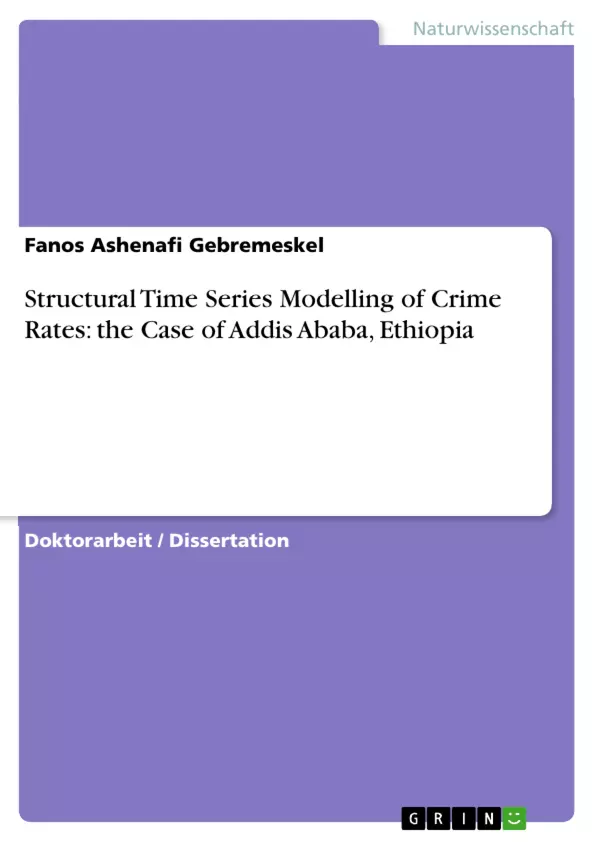The basic goal of this study was to model monthly crime rates and the impact of sentence reforms on reported crime in Addis Ababa, Ethiopia, over the study period of April 2002 to January 2012 GC by incorporating intervention effects. Monthly data obtained from Addis Ababa Police Commission for a total of 118 months were used. The impact of this legislation on reported crime rates was examined using OLS regression model and time series approaches. In particular, structural time series models were employed for the intervention analysis. The best fitted models were selected based on the model capturing the variations in the data accessed through Rs2, AIC and BIC. Comparisons of the selected model were carried out based on ability of prediction via predictive error variance. Both the local level and local linear trend models with inclusion of seasonal and cyclical effects was found to be the best fitted model for modelling of both property and violent crimes, such as murder, aggravated assault, rape, robbery, burglary and larceny. The result of the analysis shows that the coefficient of intervention was negative to rate of murder, robbery, rape and larceny but it was significant only for larceny. The effect of macroeconomic variables such as food inflation, non-food inflation, general inflation and unemployment were statistically significant for aggravated assault. It is recommended that the government and the concerned body should take some measures to tackle inflation and unemployment issues in the city. The rates of crime reported in the violent and property crimes contained seasonality. Thus, prevention mechanisms based on seasonals need to designed.
Inhaltsverzeichnis
- Title
- LIST OF TABLES
- LIST OF FIGURES
- ABSTRACT
- INTRODUCTION
- 1.1 Background
- 1.2 Statement of the Problem
- 1.3 Objective of the Study
- 1.4 Significance of the Study
- REVIEW
- 2.1 Background
- 2.2 Crime Definitions and Classifications
- 2.2.1 Personal/Violent Crimes
- 2.2.2 Property Crimes
- 2.3 Trend of Crime in Ethiopia
- 2.4 Factors or Causes of Crimes
- METHODOLOGY
- 3.1 Description of Study Area
- 3.2 Data
- 3.3 Variables used in this Study
- 3.3.1 Dependent Variables:
- 3.3.2 Independent Variables
- 3.4 Statistical Models
- 3.4.1 Regression Analysis
- 3.4.2 Intervention Component Analysis
- 3.4.3 Structural Time Series Models
- 3.4.3.1 Local Level Models
- 3.4.3.2 Local Linear Trend Models
- 3.4.3.3 Kalman Filter and Smoothing:
- 3.4.3.4 State Space Prediction and Smoothing
- 3.4.4 Parameters Estimation
- 3.5 Diagnostic and Goodness of Fit Tests for STS Model
- 3.5.1 Diagnostic Tests
- 3.5.2 Goodness of Fit Measures
- RESULTS AND DISCUSSION
- 4.1 Descriptive Statistics
- 4.2 Intervention Analysis Using Regression Model
- 4.3 STS Intervention Analysis Result
- 4.4 Parameter Estimation of State Space Model
- 4.5 Checking Adequacy of the Fitted Model
- 4.6 Prediction of Crime Rates by Using State Space Model Using the Final Models
- 4.7 Forecasting of Crime Rates by State Space Models Using the Final Models
- 4.8 Discussion
- CONCLUSIONS AND RECOMMENDATIONS
- 5.1 Conclusions
- 5.2 Recommendations
- 5.3 Limitations of the Study
- REFERENCES
- APPENDICES
- Appendix I: Results of Estimated Interventions
- Appendix 11: Results for Normality Test of Residuals for the Fitted Model
- Appendix 111: Results for Adequacy Checking of Fitted Model
- Appendix IV: Forecasted of Crime Rates by State Space Models for the Fitted Model
- BIOGRAPHY
- DECLARATION
Zielsetzung und Themenschwerpunkte
Die vorliegende Masterarbeit untersucht die monatlichen Kriminalitätsraten in Addis Abeba, Äthiopien, im Zeitraum von April 2002 bis Januar 2012. Ziel ist es, die Auswirkungen von Strafrechtsreformen auf die gemeldete Kriminalität zu modellieren und zu analysieren. Die Arbeit konzentriert sich auf die Anwendung struktureller Zeitreihenmodelle, um Interventionseffekte zu untersuchen und die wichtigsten Determinanten der Kriminalitätsraten zu identifizieren.
- Modellierung der Kriminalitätsraten unter Berücksichtigung von Interventionseffekten
- Bewertung der Auswirkungen von Strafrechtsreformen auf die Kriminalitätsraten
- Identifizierung der Beziehung zwischen Arbeitslosigkeit, Inflation und Kriminalität
- Prognose der Kriminalitätsraten in Addis Abeba auf Basis von makroökonomischen Variablen
- Bereitstellung wissenschaftlicher Erkenntnisse für Forscher und politische Entscheidungsträger
Zusammenfassung der Kapitel
Die Arbeit beginnt mit einer umfassenden Einführung in das Thema Kriminalität, ihrer Definition, Klassifizierung und den Trends in Äthiopien. Sie beleuchtet die Ursachen von Kriminalität und diskutiert die Bedeutung der Kriminalitätsprävention. Im zweiten Kapitel werden die verwendeten Daten und Methoden erläutert, einschließlich der Beschreibung des Untersuchungsgebiets, der Variablen und der angewandten statistischen Modelle. Die Arbeit konzentriert sich auf die Anwendung von strukturellen Zeitreihenmodellen, insbesondere auf das lokale Niveau- und das lokale lineare Trendmodell.
Im dritten Kapitel werden die Ergebnisse der Analyse präsentiert und diskutiert. Die Arbeit analysiert die Auswirkungen von Strafrechtsreformen, Arbeitslosigkeit und Inflation auf die Kriminalitätsraten. Die Ergebnisse zeigen, dass die Strafrechtsreformen einen signifikanten Einfluss auf die Diebstahlrate hatten, während die Auswirkungen auf andere Kriminalitätsformen weniger deutlich waren. Die makroökonomischen Variablen Arbeitslosigkeit und Inflation erwiesen sich als signifikant für die Rate an Körperverletzungen. Die Arbeit zeigt auch die saisonalen Schwankungen der Kriminalitätsraten in Addis Abeba auf.
Schlüsselwörter
Die Schlüsselwörter und Schwerpunktthemen des Textes umfassen strukturelle Zeitreihenmodelle, Kriminalitätsraten, Interventionseffekte, Strafrechtsreformen, Addis Abeba, Äthiopien, Arbeitslosigkeit, Inflation, Saisonalität.
- Arbeit zitieren
- Fanos Ashenafi Gebremeskel (Autor:in), 2012, Structural Time Series Modelling of Crime Rates: the Case of Addis Ababa, Ethiopia, München, GRIN Verlag, https://www.grin.com/document/265334



